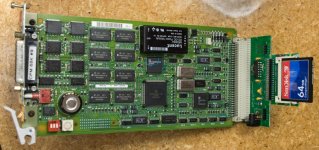Plasmo
Experienced Member
A decade ago I purchased a box of salvaged single board computers based on Motorola MC68302. They were made by ADC Communication as a controller for their Soneplex communication product line. I'd had no documentations but I figured out how to turn on the power and observed the outputs of console serial port to know these are likely good working boards.
I tried a couple times to upload my own 68000 executable files, but were not successful. Eventually I wrote a boot monitor, took over the boot flash and overwrote the existing software. In the process I also figured out most of the pc board wiring. Recently I have sufficient understanding of the board to port CP/M 68K to it.
The board has 3 banks of flash memories. The first bank is 256K bytes and hold the monitor. The other two banks are 1 megabytes each. Collectively they formed a read-only disk to hold the CP/M 68K ver 1.3 distribution files. The RAM is 1 megabyte with the top 256K backed up with a super capacitor. The backed up RAM may serve as a small RAM disk. CP/M 68k resides in $15000 - $1FFFF and the Transient Program Area is from $20000 to BFFFF, or 640K--which "ought to be enough for anybody". I copied the CP/M distribution files into flash and configured the BIOS for Flash disk and RAM disk and this is what I have:
I copied the CP/M distribution files into flash and configured the BIOS for Flash disk and RAM disk and this is what I have:
I tried a couple times to upload my own 68000 executable files, but were not successful. Eventually I wrote a boot monitor, took over the boot flash and overwrote the existing software. In the process I also figured out most of the pc board wiring. Recently I have sufficient understanding of the board to port CP/M 68K to it.
The board has 3 banks of flash memories. The first bank is 256K bytes and hold the monitor. The other two banks are 1 megabytes each. Collectively they formed a read-only disk to hold the CP/M 68K ver 1.3 distribution files. The RAM is 1 megabyte with the top 256K backed up with a super capacitor. The backed up RAM may serve as a small RAM disk. CP/M 68k resides in $15000 - $1FFFF and the Transient Program Area is from $20000 to BFFFF, or 640K--which "ought to be enough for anybody".



